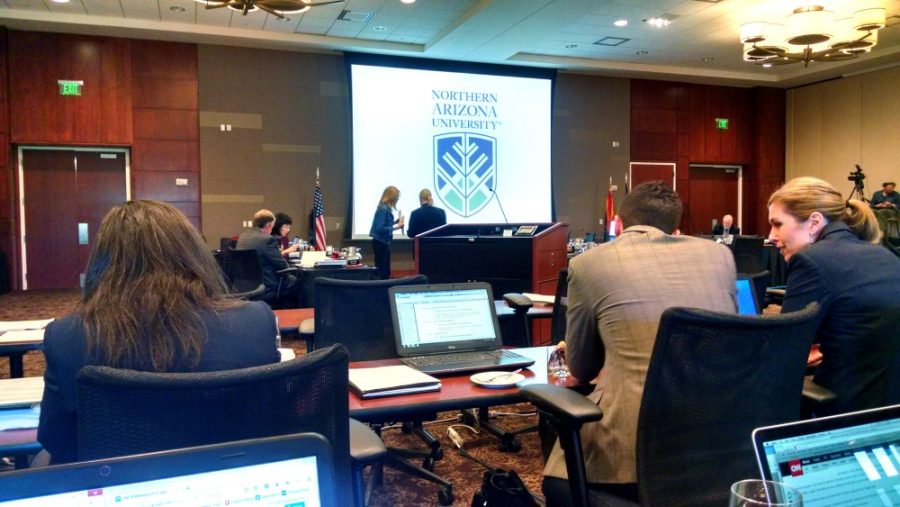The Arizona Board of Regents held its September board meeting at Northern Arizona University on Thursday. The regents had a full agenda for the day, with larger topics concerning education in the state, approval of a new strategic plan and approving a budget request for the 2016-2017 fiscal years.
The day began with President of the Board of Regents Eileen Klein’s opening remarks, the majority of which concerned the state of K-12 education in Arizona and the lack of college-eligible graduates produced by the state.
Echoed by many of the regents, the need to address “gaps in the seams” of Arizona’s education pipeline was mentioned multiple times.
“Students are falling through those gaps,” said Regent Mark Killian after outlining his feelings on K-12 education in the state.
Dr. Rita Cheng, president of NAU, was then given the floor to address the regents on the state of the university. The remainder of the morning was taken by Cheng’s report, which summarized NAU’s growth, accomplishments and strategies for the future since Cheng took office in August of last year.
Cheng also did not shy away from mentioning the difficulties that she inherited at the institution, particularly in regards to the extensive budget cuts levied against public universities by the Arizona legislature and her efforts to soften the financial burden on students.
Her poise and “deal with the hand dealt” attitude regarding the financial situation was commended and applauded by the regents. After a recess for lunch, the meeting reconvened to discuss strategies regarding the betterment of the Arizona public university system, including legislation implementing a new strategic plan and the approval of a budget request for the 2016-2017 fiscal years.
The new strategic plan for Arizona universities is outlined by four academic goals: educate, achieve, discover and impact. However, achievement of this $4 billion plan is not without its risks and challenges.
Regents members stressed the importance of measuring quality in the Arizona public university system and intensifying competitive pressures in education, which remains a challenge in the university system. A large portion of the discussion focused on debating the specific metrics that the board would use to directly measure the quality of the university system within its new strategic plan.
Regent Rick Myers, noted that the quality of a university ultimately comes down to the education students receive, and how they impact the state after graduation.
“What matters is: are we making a difference in the state of Arizona?” Myers said.
The regents also discussed the importance of diversity and the challenge of breaking cultural barriers. While minority groups continue to grow in comparison to current enrollment rates, the heterogeneity of the student population remains stagnant.
“If we change the way we communicate … we can change the culture at the university,” said Arizona State University President Michael Crow regarding the discrepancy in student-wide minority groups.
Regent members later voted to install this new strategic plan for the coming 2017 fiscal year. UA President Ann Weaver Hart noted that the plan can be used as a format for universities to enhance their own approach in education reform.
Budgeting was also a heated topic among those at the round table. The regents noted that all three Arizona universities would be spending less per student in comparison to the 2010 fiscal year, and will be expecting cuts to be at $99 million directly from public institutions.
It was recorded that at least 18 percent of funding for public universities would be cut in the 2016 fiscal year. They also project a net loss of $3,694 per resident students in fiscal year 2016.
The board also approved to raise the requirement for university employee benefits from 20 hours per week, to the federal level of 30 hours per week. To conclude the first meeting, in response to the impending budget cuts, the board unanimously voted to install a new funding legislation plan for the 2016-2017 fiscal year.
The board continued the September meeting Friday morning, starting off with student regent statements before by a report from the Arizona Faculties Council.
Follow Sam Gross and Lauren Renteria on Twitter.









